Journey to Pokhara Valley and the Himalayas of Nepal
Encounters with Tibetan Refugees Creating a New Life
Article and photos by Donna J. Moore
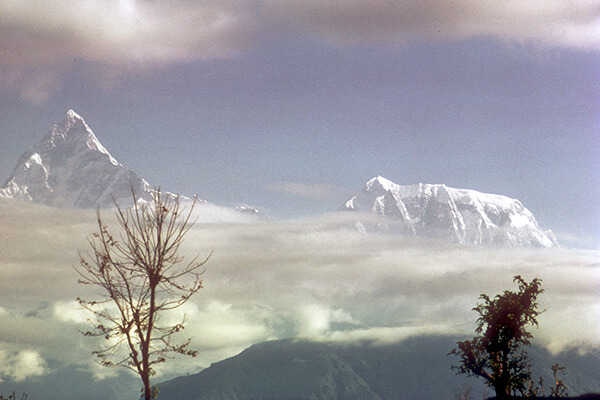
|
|
A view of the Himalayas from the skies above Pokhara Valley in Nepal.
|
The small, single-engine plane carried only a few passengers. We arrived mid-morning. While coming in for the landing, I was startled by a strange wailing siren. I looked out the window and saw several men running around a grassy meadow, shooing away a herd of cows. In contrast, another man cranked an old siren. After the cows had been rounded up, we landed in Pokhara Valley, which was rather bumpy.
This isolated valley lies 3,500 feet above sea level and 96 miles NW of Kathmandu in an area known as the “Switzerland of Nepal.” From Pokhara, if clouds don't obscure them, one can see the entire Annapurna range, Machhapuchhara (the fish-tail mountain), and even Mount Everest. I was fortunate to visit this beautiful valley in 1962 when I was on vacation from my State Department assignment in Dacca, East Pakistan (now Bangladesh).
The Royal Nepalese Airlines stopped there twice a day — once in the morning en route to Mustang on the Nepal-Tibet border and again in the afternoon before returning to Kathmandu. The only other way to reach this isolated area was by foot or horseback, a trip that took several days. With neither cars nor electricity, Pokhara sounded like a modern-day Shangri-la. I was determined to see it.
Beside the "runway" was a small, corrugated tin shed over which the Royal Nepalese Airlines flag flew. Next door was a mud and wattle structure, which turned out to be a livery stable run by a Tibetan family, part of the large population of Tibetan refugees in this part of Nepal. These two buildings and the shared water spigot were the only signs of civilization. Off in one direction ran a well-worn path. Several less well-defined paths meandered who knows where.
I was excited as I got off the plane. I love mountains, and seeing some of the world’s highest mountains has drawn me to this place. However, I also felt somewhat frightened as I watched the plane take off again for Mustang. I was alone, didn't speak the language, and was unsure what to do next. Would the plane come back? Would I be OK? Would I find my way to the village and back? Screwing up my courage, I headed down the path the pilot had assured me led to the village.
After a short walk, I came to a cluster of charming, mostly 1-story houses. A couple of simple shops selling basic supplies made it clear Pokhara was no tourist town. Colorful flowers twined around the old wooden doorways, and the rock and mud buildings with simple thatched roofs made wonderful subjects for my camera.

|
|
A Pokhara village in Nepal.
|
I noticed some children playing on the steps of one of the houses. With a start, I realized they were playing jacks. Instead of balls and star-shaped metal jacks, they used small pebbles, but it was clear that their game was the same as the one I had played as a child back in Tacoma. Nepalese children are beautiful with round, happy faces, honey-colored skin, and sparkling brown eyes. While these children's clothes were quite ragged and worn, they were charming and seemed as curious about me as I was about them. Before long, a gaggle of children followed me every footstep, but no one asked for bakshish as they always did in Dacca. I felt like the Pied Piper.
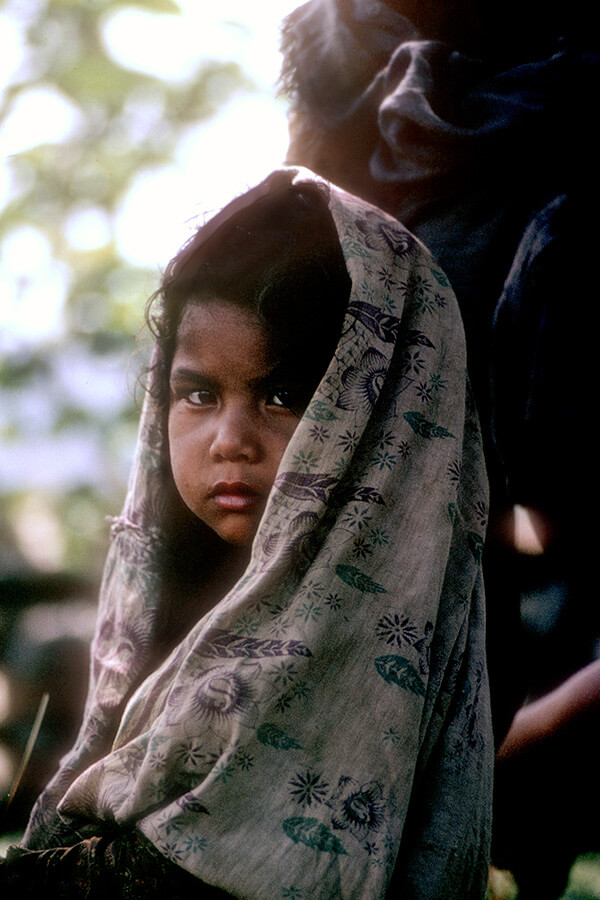
|
|
A child in Nepal.
|
After a few hours of wandering about and picture-taking, I returned to the "airfield." I did not want to miss that return plane to Kathmandu. Peeking through the window of the small tin shed beside the "runway," I could see a narrow charpoy or cot was the only piece of furniture. It did not look very inviting. The shed was a rest house for airline pilots grounded by bad weather, a fairly common occurrence so high in the Himalayas.
Several fierce-looking Tibetan men squatted against the rock wall beside the livery stable. With their shiny black hair, Tibetan women pulled back in braids, heavy coral and turquoise jewelry, and colorful patchwork aprons over long traditional dresses are lovely. While Tibetan men also wear colorful clothing, they look fearsome with their large mustaches and piercing black eyes.
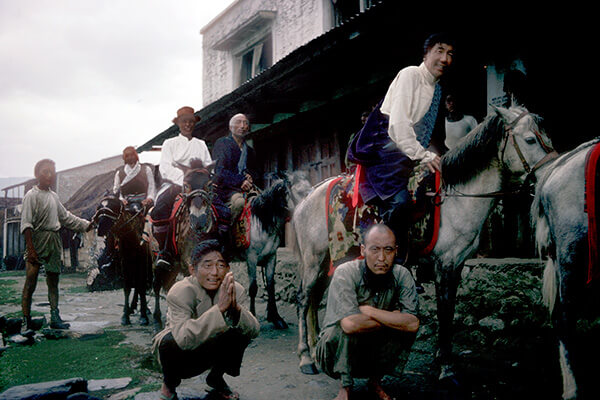
|
|
Tibetan men squatting, with others on their horses.
|
I was surprised to see a Western woman and a little girl seated on the rock wall, apparently also waiting for the plane. The woman said she was an American photographer. She and her daughter had just returned from visiting a Tibetan refugee encampment, about a two-hour hike up the valley. One of the first groups to escape the Chinese invasion, they had arrived just a few days before me.
The more she talked, the more excited I became about the possibility of visiting them. Ever since I was a kid, I have been fascinated by Tibet. I clearly remember hearing Lowell Thomas announce on the radio: "This is Lowell Thomas broadcasting from the top of the world." I had planned to travel there, but the Chinese invasion in 1959 had squashed that dream. "It would be the chance of a lifetime!" the woman said, urging me to stay and take the plane back the next day. She and her daughter had remained in the rest house and had a meal with the Tibetan family at the livery stable, and she convinced me I should do the same.
If she and her daughter had stayed in that shed overnight, surely a healthy, thirty-year-old woman like me should be able to do it as well. I was only wearing a light cotton dress. Luckily, I bought a sizeable pashmena shawl in the bazaar the day before. Fearing the plane ride might be chilly, I had brought it along. Since I now had a "blanket," I decided to stay. The wailing siren announced the plane's arrival as I dashed up the hill to the livery stable to make arrangements. Later, watching the plane take off, I nervously waved goodbye to the woman and her daughter and turned to settle into my new accommodations.
My evening meal consisted of Tibetan tea (a spicy brew of milk, tea, and pepper), chapattis, and boiled potatoes eaten with the Tibetan family while sitting on the floor around their communal cooking pot. I relished the plain but filling meal because I was hungry. While the modest meal was not memorable, the rest of the night was. Until the sun went down and the birds found a place to roost, it sounded as though they were tap dancing in wooden shoes on the corrugated tin roof of the hut. Huddled under my shawl, trying to keep warm, I did not sleep much. It gets cold at night at that altitude.
The dancing birds awoke me the following day at sunrise, and I hurried outside to try to spot the mountains. The valley was beautiful in the early morning sunshine, but the mountains still lay hidden in the mist. I washed my face and hands at the water pump and headed to the livery stable for a breakfast of more "chapattis" and Tibetan Tea. I was getting to quite like that spicy brew.
The man who ran the livery stable spoke some English and agreed to rent me one of his ponies. However, he suggested it would be better if his young son led me to the refugee camp. He was afraid I might get lost. His wife, concerned about my lack of trousers, loaned me a pair of baggy green cotton drawers with a drawstring waist. She also insisted I carry her big black umbrella to protect my fair skin from the sun, which is fierce at those high altitudes. As the day wore on, I was very grateful for her thoughtfulness.
Dressed in my red and white checked cotton shirt over the green baggy drawers and carrying the big black umbrella, I must have looked quite a sight perched atop the colorful Tibetan rugs that served as the small pony's saddle. In addition, since I am pretty tall, my legs dangled down the pony's sides, and my feet nearly touched the ground.
As the boy and I slowly wound through the lovely countryside, occasional glimpses of Machhapuchhara and the Annapurna range appeared as the clouds cleared. Once, I even spotted the tip of Mt. Everest — at least, I think that's what the boy said. We stopped to photograph the colorful flowers crawling over the crumbling stonewalls that flanked the path beside a crystal clear brook. The clopping of the pony's hoofs on the stone path through the village announced our presence. Our little caravan must have been unusual, as villagers frequently ran out of their huts to wave.
After several hours, I spotted several white Tibetan prayer flags waving from long bamboo poles perched high on a hillside. I dismounted from the pony and started walking towards the flags just as a crowd of women and children ran towards me. When we met, they stuck out their tongues and bowed deeply from the waist, a traditional Tibetan greeting. The children grabbed my hands, and the bowing and giggling women seemed thrilled to see me. I felt like an honored guest. A white-haired woman in a nurse's uniform stepped out of a nearby tent and introduced herself. This kindly-faced Swiss woman was the manager of the camp. She invited me to explore wherever I liked.
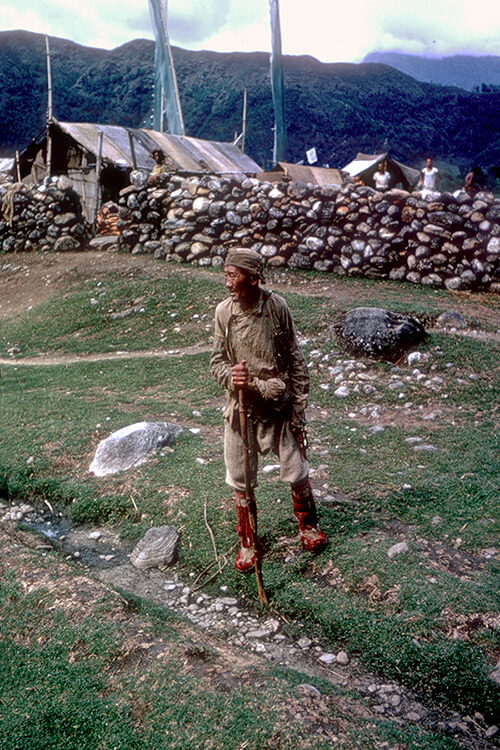
|
|
An older Tibetan man.
|
Suddenly, a group of fierce-looking men came running toward me. Many had beads of turquoise and coral clasped around their necks and threaded through their earlobes. Instead of the traditional brightly-colored, pieced-leather boots, dark red woolen jackets thrown over one shoulder and clasped around the waists with a wide leather belt, many wore camouflage jackets, pants, and western-style boots.
I was even more startled when they lined up like schoolboys, indicating they wanted their picture taken. Obediently, I whipped out my camera. After several snapshots, they crowded around, demanding to see the results. I realized the American woman photographer who had visited the day before must have had a Polaroid Instamatic. I was hard-pressed to explain why my camera produced less impressive results. They must have thought I was holding out on them, as several got quite angry. Given their already wild appearance, their fierce scowls made them look even more formidable. The Swiss woman came to my rescue by explaining the difference in the cameras and assuring the men that I was not cheating them.
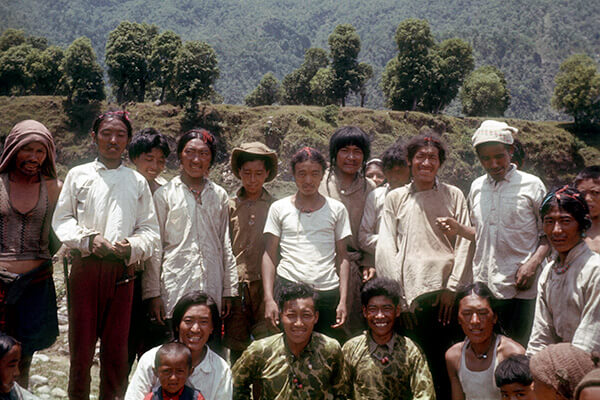
|
|
A group of Tibetan refugees.
|
While she gave me a tour of the camp, she explained that after the Chinese invasion of Tibet in the late 1950s, receiving areas like hers had been set up near the Tibetan border in northern India and Nepal. This particular group of refugees — who had been herdsmen and nomads — would be trained to weave rugs. She hoped to eventually relocate them as a group closer to Katmandu.
The repression of the peaceful and gentle people of Tibet was a sad chapter in the world's history. "Over 1 million people out of a population of 6 million died at the brutal hands of the Chinese and Tibet's vast forests were cut down and the wildlife almost totally massacred," according to Sogyal Rinpoche, author of The Tibetan Book of Living and Dying. "The vast majority of its 6,500 monasteries lie gutted or destroyed, and the Tibetan people face extinction, and the glory of their own culture in their homeland has been almost entirely obliterated. Spiritual masters, monks, and nuns were their first targets because the Chinese Communists wanted, above all, to break the spirit of the people by wiping out all traces of religious life."
Today, thousands of Tibetans live in exile, with hundreds right here in the Seattle area. According to the Dalai Lama, there are now more Tibetans residing outside their own country than within its borders. While my story takes place over 50 years ago, hopefully, the world will never forget what was done to these people by the Chinese.
Thinking back to my adventure off-the-beaten path in Nepal, I realize whatever dangers were present evolved primarily out of my fear of the unknown. Admittedly, it was more challenging in those days to let people know where I was or call for help since there were no cell phones and email did not exist. However, there were usually radio hookups in remote villages like Pokhara. I also knew the Embassy staff in Katmandu would respond if I got into trouble. But, of course, that resource is also available to travelers today. Restaurants and motels were nonexistent, but I have always found that some kind people make accommodations if you are looking for them.
On the other hand, guerillas and pirates who kidnap travelers for ransom are a new phenomenon. Sometimes, however, these stories are just overblown accounts from some reporter's vivid imagination and must be carefully checked out. I remember dozens of occasions when I had to reassure my mother that I was safe after she had read some scary article in the paper. In the sixties, Americans were admired in most parts of the world, which made travel to remote places less risky. While this is not universally true today, most people still like Americans. They often do not like the politics practiced by the country.
The things that make travel really dangerous are war and disease — elements one cannot control. I always carefully researched the situation and avoided it if the risk was too high. That is a lot easier to do today by using the internet. Dangers that are mainly in the mind — fear of the unknown, fear of feeling foolish, and fear of being seen as "different" — hold many travelers back from the possibility of a great adventure. I try to go without some preset idea of what I want to happen. For me, the real fun of travel is keeping oneself open to possibilities.
Donna Moore has lived on Bainbridge Island in the State of Washington since 1976. Since she retired from federal employment in 1985, she has spent her time in various volunteer activities. She is writing a memoir about her fifteen years living overseas in the Foreign Service. This story is taken from that work. Her other publications include a book on career search for federal employees, experiential exercises for building spiritual community, and a book of Haiku poetry.
|
